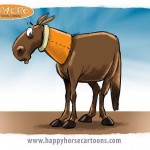
Does your horse travel with his head tipped to one side? Will he bend his neck better to one direction than the other? Is he having trouble getting his hind legs underneath him to stop, turn, or back up? These are problems that could be diagnosed and treated using osteopathy.
We palpate and “read” the horse’s spine to tell us about problems in the horse’s body. An example of internal inflammation would be ovaries that are restricted, resulting in decreased mobility of the hind limbs. We could tell that the ovaries were restricted by finding a restriction at lumbar vertebrae L1 through L3.
Osteopathic manipulation of the problem ovaries will resolve the problem with the hind legs. The autonomic nervous system must be working for the immune system to be strong. Any restriction in the organs or joints will decrease the ability of the autonomic nervous system to function properly.
A horse that is sensitive when you touch his ears or try to bridle him could have a restriction in his temporal bone, a problem in his TMJ joint, his mastoid process, or his occiput. Once this restriction is removed, he will be much more willing to have his ears touched or his bridle put on.
A mare with a restriction of the ovary in the area of the fallopian tube may not get pregnant. Once this restriction is removed, using internal osteopathic manipulation, the egg will move down the fallopian tube and the mare would have a much better chance of getting pregnant. An osteopathic treatment can restore function, and therefore innervation and circulation to the body.
This tip was brought to you by Lu Ann Groves, DVM (www.thewholehorse.com) and KAM Animal Services, home of KAM’s “Equine Learning Circle” FREE webinars, which take place monthly. These webinars are an expansion of KAM’s weekly tips. Go to www.kamanimalservices.com to sign up for the next webinar. The FREE webinars will conclude with a question and answer session, so be ready with your nutrition questions.